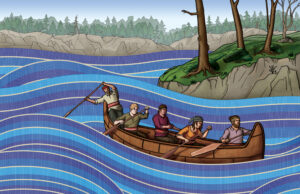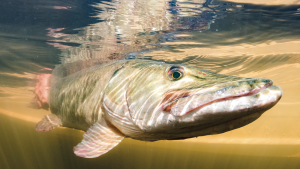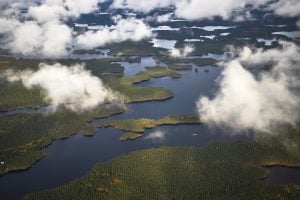
People & Culture
Rivers of resistance: A history of the Métis Nation of Ontario
“We were tired of hiding behind trees.” The ebb and flow of Métis history as it has unfolded on Ontario’s shores
- 4405 words
- 18 minutes
Environment

Lake Ontario’s ecology experienced a major shift in the 19th century as logging and land management practices changed, according to new research by Eric Guiry, a postdoctoral fellow at Trent University.
Published in the Journal of Limnology and Oceanography, Guiry’s research suggests nitrogen levels in the lake increased in the 1830s after at least 800 years of stability due to widespread deforestation in its watershed.
Guiry says the idea for this research came from another project in which he was looking at whether or not Lake Ontario’s original salmon population had migrated to the ocean and back.
“We’ve known that humans have been responsible for messing up lakes for quite a while, and the process of nutrification—putting too many nutrients in the lake—has had some major impacts,” he says.
Guiry’s research shows that Lake Ontario’s balance began to shift when forests around the lake were cleared, allowing more nitrogen-rich soil to wash into the lake.
“One of the major findings was pinpointing when the process began. That gave us a window in which we could look at the kinds of historical processes happening that might have been behind it,” he says. “We were able to rule out some potential contributors, and the main one that fit all the aspects of the timeframe was deforestation.”
Guiry analyzed archeological bones of fish such as lake trout, Atlantic salmon and whitefish to determine the amount of nitrogen-15 in the lake at various times. He says one of the most interesting things about his research is the wide range of samples he had access to — including one dating back to approximately 980 AD.
“I was amazed by the abundance of scientific resources in the archaeological record — how many samples can be obtained from what are, in some cases, extinct species,” he says. “Often in our geology we find these messy fingerprints of what happened in the past, but these samples made it extremely clear.”
While Guiry’s research shows a correlation between deforestation and rising nitrogen levels in Lake Ontario, a big question that remains is how this impacted freshwater species at the time.
“What we’re really looking at is an incipient beginning or signature of change, so how the fish in the ecosystems actually experienced that change would still be open to question,” he says. “We know that later on the effects were changes in oxygen levels and the introduction of harmful algal blooms.”
Guiry says the next step will be to continue examining the ecology of the lake in the contemporary and pre-contact period, and looking at the impact of changing nitrogen levels on more threatened freshwater species like eels and sturgeons.
Are you passionate about Canadian geography?
You can support Canadian Geographic in 3 ways:

People & Culture
“We were tired of hiding behind trees.” The ebb and flow of Métis history as it has unfolded on Ontario’s shores

Environment
David Boyd, a Canadian environmental lawyer and UN Special Rapporteur on Human Rights and the Environment, reveals how recognizing the human right to a healthy environment can spur positive action for the planet

Environment
How a cocktail of invasive species and global change is altering the Great Lakes-St. Lawrence River ecosystem

People & Culture
Uprooted repeatedly by development projects, the Oujé-Bougoumou Cree wandered boreal Quebec for 70 years before finding a permanent home. For some, the journey continues.